 RODAN
(1956)/WAR OF THE GARGANTUAS (1966)
RODAN
(1956)/WAR OF THE GARGANTUAS (1966)Directed by Ishiro Honda
Classic Media
 RODAN
(1956)/WAR OF THE GARGANTUAS (1966)
RODAN
(1956)/WAR OF THE GARGANTUAS (1966)After the enormous success of GOJIRA (GODZILLA) in 1954 and the acceptable performance of its sequel, GODZILLA RAIDS AGAIN, Toho Company Ltd. producer Tomoyuki Tanaka along with director Ishiro Honda and special effects wizard Eiji Tsuburaya and composer Akira Ifukubie once again combined their talents to bring another giant behemoth to life. The result was the 1956 release of RODAN (RADON in Japan) which not only features even better special effects and photography than GODZILLA, but was also the first “kaiju eiga” (monster film) in beautiful living color. As part of their recent releases of GODZILLA films to DVD, Classic Media has released an impressive two-DVD collection of not only the Japanese and American versions of RODAN, but also the Japanese and American versions of one of the most fondly remembered monster films…1966’s WAR OF THE GARGANTUAS. Finally, genre fans have a definitive release of both films which boasts a beautiful looking hard shell case which would look terrific on any collector’s shelf.
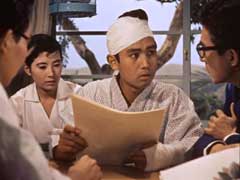
Terror begins to overrun the small Japanese mining village of Kitamatsu on the southern most island, Kyushu. Miners begin disappearing only to be found later slashed to death. The authorities are at a loss for an explanation until the culprits make themselves known in the shape of giant insect-like creatures which have been mutated as a result of the radiation from atomic bomb testing. One brave miner Shigeru (Kenji Sahara, a regular in Toho monster films) attempts to destroy the monsters, but a mine cave-in traps him for several days beneath the earth. Although he is rescued, Shigeru emerges from the ordeal in a state of shock and suffering from amnesia and not because of the giant insects. It is later revealed that Shigeru witnessed the emergence of a gigantic pterodactyl-like creature from a huge egg. After his memory returns, Shigeru takes leading scientists to the site and they confirm that indeed a huge monster from the Jurassic age has hatched and is causing terror in the skies over Asia. The species is classified as Rodan.
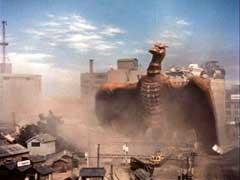 Eventually,
the giant Rodan attacks a major city, Saseabo and proceeds to destroy the city
with hurricane-like winds generated from its massive wingspan. Suddenly, as
the military seems to be overpowering the monster, a second Rodan flies overhead
and rescues its mate, leaving the city in ruins. In order to rid the world of
these creatures, the military devises a plan to blow up their volcanic mountain
hideout and bury the creatures alive in the molten lava.
Eventually,
the giant Rodan attacks a major city, Saseabo and proceeds to destroy the city
with hurricane-like winds generated from its massive wingspan. Suddenly, as
the military seems to be overpowering the monster, a second Rodan flies overhead
and rescues its mate, leaving the city in ruins. In order to rid the world of
these creatures, the military devises a plan to blow up their volcanic mountain
hideout and bury the creatures alive in the molten lava.
RODAN became a box office success both in its native Japan when it was released in December 1956 and on its United States release by the King Brothers (who also produced 1960’s GORGO) in the summer of 1957. In some drive-ins, it was double-billed with a re-release of GODZILLA, KING OF THE MONSTERS. The monster proved sufficiently popular for Toho to revive him for three sequels (GHIDRAH, THE THREE HEADED MONSTER, MONSTER ZERO and DESTROY ALL MONSTERS).
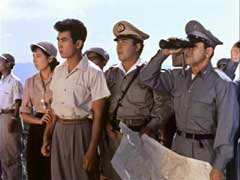 Classic
Media has produced an excellent presentation of the Japanese version complete
with newly translated subtitles and excellent audio. One of the biggest problems
with Toho’s films produced from 1954 through 1962 was the use of inferior
film stock plus the fact that their film vaults were not protected in those
days from excess dust which ended up on the prints and negatives. Thus films
like GODZILLA, RODAN, THE MYSTERIANS, VARAN and even KING KONG VS. GODZILLA
tend to look grainy and scratchy throughout (this is ESPECIALLY true for the
original 1954 GODZILLA). RODAN actually fares remarkably well on DVD (at least
for the Japanese version). The picture and colors are fairly sharp with an aspect
ratio of 1.33. RODAN was the last Toho monster film shot in 1.33. Beginning
in 1957 with THE MYSTERIANS, TohoScope 2.35:1 was the shooting
norm until 1977 (WAR IN SPACE).
Classic
Media has produced an excellent presentation of the Japanese version complete
with newly translated subtitles and excellent audio. One of the biggest problems
with Toho’s films produced from 1954 through 1962 was the use of inferior
film stock plus the fact that their film vaults were not protected in those
days from excess dust which ended up on the prints and negatives. Thus films
like GODZILLA, RODAN, THE MYSTERIANS, VARAN and even KING KONG VS. GODZILLA
tend to look grainy and scratchy throughout (this is ESPECIALLY true for the
original 1954 GODZILLA). RODAN actually fares remarkably well on DVD (at least
for the Japanese version). The picture and colors are fairly sharp with an aspect
ratio of 1.33. RODAN was the last Toho monster film shot in 1.33. Beginning
in 1957 with THE MYSTERIANS, TohoScope 2.35:1 was the shooting
norm until 1977 (WAR IN SPACE).
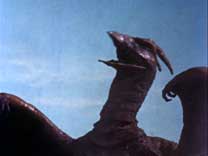
The biggest drawback with the DVD presentation of the American version of RODAN which must be noted here for the buying public to see is the fact that it is the same print (complete with the erroneous MCMXXXIV 1934 copyright superimposed on the title card) used for Classic Media’s 2002 release with which many genre fans were disappointed. However, the print is not really all that bad and represents the uncut 72 minute version as was released in the United States in 1957 (the complete Japanese version runs 82 minutes).
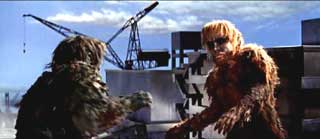 On
a separate disc included in the set is arguably one the most requested Toho
titles to debut on DVD. Of course, this is the 1966 cult classic WAR OF THE
GARGANTUAS which actually had somewhat of an interesting history before its
1970 United States release on a double bill with MONSTER ZERO. On
a dangerously stormy night, a ship is suddenly attacked by a giant octopus.
When it looks like doom for the captain, the sudden appearance of a giant hairy
green monster drives the octopus away only to lead to the crew members being
eaten alive by the Gargantua with only the captain surviving.
On
a separate disc included in the set is arguably one the most requested Toho
titles to debut on DVD. Of course, this is the 1966 cult classic WAR OF THE
GARGANTUAS which actually had somewhat of an interesting history before its
1970 United States release on a double bill with MONSTER ZERO. On
a dangerously stormy night, a ship is suddenly attacked by a giant octopus.
When it looks like doom for the captain, the sudden appearance of a giant hairy
green monster drives the octopus away only to lead to the crew members being
eaten alive by the Gargantua with only the captain surviving.

Authorities are baffled by the shipwreck and by the ramblings of the captain who now suffers from exhaustion and shock. To get answers, the authorities contact “Frankenstein expert” (at least that’s what he is called in the Japanese language version) Dr. Paul Stewart (Russ Tamblyn) and his assistant Dr. Akemi Kita (Kumi Mizuno) who once raised a similar looking brown creature in Kyoto before it grew and escaped and was pronounced dead. Since Dr. Stewart’s monster was brown and gentle with humans, they become increasingly convinced that this green giant is not the same as their Gargantua, but a mutated offshoot spawned from the cells of their creature.
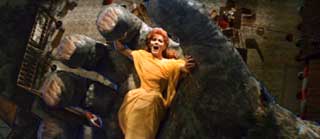 After
a vicious attack on Tokyo Airport (in which a hapless employee is gobbled up
and her clothes unceremoniously spat out on the pavement) and an attack on a
Tokyo nightclub in which American actress Kipp Hamilton laughably “sings”
the ditty, “The Words Get Stuck in My Throat,” and almost becomes
a midnight snack, the Green Gargantua (Gaila as he is called in the Japanese
version) escapes into the woods. The military relentlessly pursues Gaila and
actually gets the upper hand with a new invention, the Laser Canon which is
capable of sending electric shocks to the monster. When it looks like Gaila
is down for the count, his brown twin brother, Sanda arrives and mercifully
rescues his green brother. After initially showing kindness to Gaila, Sanda
later realizes how evil his brother is and in an epic climax set in the middle
of Tokyo, the two engage in a titanic struggle.
After
a vicious attack on Tokyo Airport (in which a hapless employee is gobbled up
and her clothes unceremoniously spat out on the pavement) and an attack on a
Tokyo nightclub in which American actress Kipp Hamilton laughably “sings”
the ditty, “The Words Get Stuck in My Throat,” and almost becomes
a midnight snack, the Green Gargantua (Gaila as he is called in the Japanese
version) escapes into the woods. The military relentlessly pursues Gaila and
actually gets the upper hand with a new invention, the Laser Canon which is
capable of sending electric shocks to the monster. When it looks like Gaila
is down for the count, his brown twin brother, Sanda arrives and mercifully
rescues his green brother. After initially showing kindness to Gaila, Sanda
later realizes how evil his brother is and in an epic climax set in the middle
of Tokyo, the two engage in a titanic struggle.
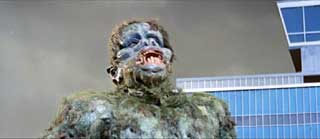
The genesis of what eventually became WAR OF THE GARGANTUAS actually started as an official sequel to 1965’s FRANKENSTEIN CONQUERS THE WORLD. At the climax of that film, the giant Frankenstein was swallowed up by an earthquake after defeating the dinosaur Baragon. In the original synopsis of WAR OF THE GARGANTUAS, it was implied that Gaila was spawned from the disembodied hand from the first film and that Sanda was actually the fully grown Frankenstein monster from the first film. Several script changes coupled with the fact the resulting monster costumes looked nothing like the Frankenstein monster from FRANKENSTEIN CONQUERS THE WORLD, American producer Henry G. Saperstein decided the creatures looked more gorilla-like and arranged to have all references to Frankenstein and the events from the previous film dropped from the English language version. However, the Japanese version and the alternate “international” English version (in which Russ Tamblyn’s voice is dubbed by another actor) feature references to Frankenstein although even in these versions, script changes blurred the relationship between FRANKENSTEIN CONQUERS THE WORLD and WAR OF THE GARGANTUAS even further.
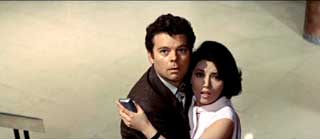 The
cast of WAR OF THE GARGANTUAS is headlined (at least in the English version…in
the Japanese version, he is third billed in the credits) by Hollywood actor
Russ Tamblyn co-star of such classic films as WEST SIDE STORY (1961), HOW THE
WEST WAS WON (1963), THE HAUNTING (1963…arguably one of the best ghost
stories ever made), and SEVEN BRIDES FOR SEVEN BROTHERS (1954). Mr. Tamblyn
admitted he accepted the job more or less to get a working vacation in Japan
with no real expectation of any American release and even less of an expectation
that the film would become the cult classic it has become over the years. In
fact, a couple of years ago when the film was screened in a re-mastered 35mm
print in California, Mr. Tamblyn (who had never seen the finished film) was
an invited guest and actually thought that it was not really all that bad after
all. He freely and unapologetically admits that while watching himself as he
looked in 1966 that “I phoned in that performance,” the overall
film was not as bad as he thought it would be and he seemed amazed and pleased
that the film has achieved this cult status longevity.
The
cast of WAR OF THE GARGANTUAS is headlined (at least in the English version…in
the Japanese version, he is third billed in the credits) by Hollywood actor
Russ Tamblyn co-star of such classic films as WEST SIDE STORY (1961), HOW THE
WEST WAS WON (1963), THE HAUNTING (1963…arguably one of the best ghost
stories ever made), and SEVEN BRIDES FOR SEVEN BROTHERS (1954). Mr. Tamblyn
admitted he accepted the job more or less to get a working vacation in Japan
with no real expectation of any American release and even less of an expectation
that the film would become the cult classic it has become over the years. In
fact, a couple of years ago when the film was screened in a re-mastered 35mm
print in California, Mr. Tamblyn (who had never seen the finished film) was
an invited guest and actually thought that it was not really all that bad after
all. He freely and unapologetically admits that while watching himself as he
looked in 1966 that “I phoned in that performance,” the overall
film was not as bad as he thought it would be and he seemed amazed and pleased
that the film has achieved this cult status longevity.

The rest of the cast features such Toho monster film veterans as Kenji Sahara from RODAN (1956), THE MYSTERIANS (1957), THE H-MAN (1958) and KING KONG VS. GODZILLA (1963). The beautiful Kumi Mizuno returns more or less reprising her “Seuko Togami” role from FRANKENSTEIN CONQUERS THE WORLD while Jun Tazaki is back playing another one of his authoritative military roles. Mr. Tazaki was a familiar face in Toho films usually portraying generals or scientists. Of course, stuntman/suit actor Haruo Nakajima is back as Gaila and according to Nakajima-san, Gaila was his favorite role next to Godzilla. Hiroshi Sekita portrayed Sanda and the two stunt men would work again as foes in GODZILLA VS. THE SEA MONSTER (1966) and KING KONG ESCAPES (1967…Nakajima played King Kong and Sekita played the robot, Mechani-Kong).
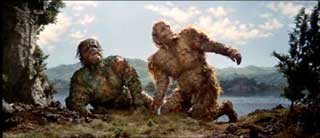 On
the technical side, WAR OF THE GARGANTUAS features some of Eiji Tsuburaya’s
best special effects work. By now, he was pulling double duty between feature
films as well as television work with ULTRAMAN and ULTRA Q making him one of
the busiest special effects directors in Japan. In addition, one of the distinguishing
factors of the Japanese version of WAR OF THE GARGANTUAS is the rousing military
march theme conducted by maestro Akira Ifukubie (a theme much in the style of
Mr. Ifukubie’s march in 1968’s DESTROY ALL MONSTERS). Unfortunately,
for some unclear reason, the catchy “Operation L March” theme was
eliminated for the film’s United States release and replaced with library
music from the John Carradine film, THE INCREDIBLE PETRIFIED WORLD (1957). Now
with the official release of the Japanese version on American DVD, fans can
listen to Mr. Ifukubie’s score as he originally intended.
On
the technical side, WAR OF THE GARGANTUAS features some of Eiji Tsuburaya’s
best special effects work. By now, he was pulling double duty between feature
films as well as television work with ULTRAMAN and ULTRA Q making him one of
the busiest special effects directors in Japan. In addition, one of the distinguishing
factors of the Japanese version of WAR OF THE GARGANTUAS is the rousing military
march theme conducted by maestro Akira Ifukubie (a theme much in the style of
Mr. Ifukubie’s march in 1968’s DESTROY ALL MONSTERS). Unfortunately,
for some unclear reason, the catchy “Operation L March” theme was
eliminated for the film’s United States release and replaced with library
music from the John Carradine film, THE INCREDIBLE PETRIFIED WORLD (1957). Now
with the official release of the Japanese version on American DVD, fans can
listen to Mr. Ifukubie’s score as he originally intended.

Classic Media has done a great job in presenting WAR OF THE GARGANTUAS to an eager public. For years, genre fans had to put up with poor pan and scan VHS/laserdiscs releases, but now, the American version FINALLY gets a proper widescreen (2.35:1) re-mastering with anamorphic enhancement for 16x9 television sets. Colors are very vibrant with a very clear picture and the audio sounds fine in Dolby Digital 2.0. The Japanese version although excellent in many ways, unfortunately is also a tad dark in some of the key night time scenes. The Japanese audio is uniformly excellent throughout and the video is also anamorphically enhanced for 16x9 televisions.
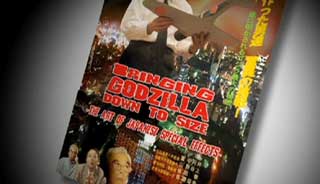 While
the other releases in Classic Media’s GODZILLA series all featured audio
commentaries and Japanese trailers, unfortunately, RODAN and WAR OF THE GARGANTUAS
do not. However, the one extra is an excellent 60 minute + documentary called,
BRINGING GODZILLA DOWN TO SIZE. This is a fine and informative feature which
traces the history of special effects in Japanese films as well as a biography
on Eiji Tsuburaya, featuring interviews with his surviving sons as well as the
son of the late Ishiro Honda. In addition, such familiar Toho genre actors like
Akira Takarada, Yoshio Tsuchiya, and Hiroshi Koizumi are all interviewed and
speak enthusiastically and very proudly about being a part of such film history
appreciated by fans all over the world.
While
the other releases in Classic Media’s GODZILLA series all featured audio
commentaries and Japanese trailers, unfortunately, RODAN and WAR OF THE GARGANTUAS
do not. However, the one extra is an excellent 60 minute + documentary called,
BRINGING GODZILLA DOWN TO SIZE. This is a fine and informative feature which
traces the history of special effects in Japanese films as well as a biography
on Eiji Tsuburaya, featuring interviews with his surviving sons as well as the
son of the late Ishiro Honda. In addition, such familiar Toho genre actors like
Akira Takarada, Yoshio Tsuchiya, and Hiroshi Koizumi are all interviewed and
speak enthusiastically and very proudly about being a part of such film history
appreciated by fans all over the world.
All in all, Classic Media has done quite a good job in their presentation and Japanese monster movie fans will be eager to have these definitive presentations on their DVD shelves. It seems that for the time being, the company has released all their presently owned Toho titles on DVDs and as of 2008 nearly all of the Godzilla titles of the classic era (1954-1975) are out on region one DVD from various companies. It now remains to be seen if ADV will one day present a proper anamorphically enhanced version of DESTROY ALL MONSTERS with special features instead of the bare bones DVD presently available and also if GODZILLA VS. MEGALON will one day get a widescreen/anamorphically enhanced presentation instead of the horrible bootleg DVDs now available. Well…one can hope…in the meantime, let us enjoy the official and beautiful looking Godzilla and Toho DVDs now available. (Joe Cascio)